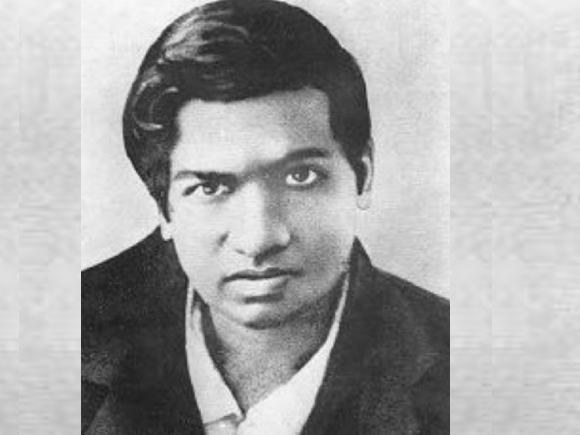One cold winter morning in 1913, the English mathematician G. H. Hardy received a strange letter from an unknown clerk in Madras, India. The ten-page letter contained about 120 statements of theorems on infinite series, improper integrals, continued fractions, and number theory. Every prominent mathematician gets letters from cranks, and at first glance Hardy no doubt put this letter in that class. But something about the formulas made him take a second look, and show it to his collaborator J. E. Littlewood. After a few hours, they concluded that the results “must be true because, if they were not true, no one would have had the imagination to invent them”.
Thus was Srinivasa Ramanujan (1887-1920) introduced to the mathematical world. Born in South India, Ramanujan was a promising student, winning academic prizes in high school. But at age 16 his life took a decisive turn after he obtained a book titled A Synopsis of Elementary Results in Pure and Applied Mathematics. The book was simply a compilation of thousands of mathematical results, most set down with little or no indication of proof. It was in no sense a mathematical classic; rather, it was written as an aid to coaching English mathematics students facing the notoriously difficult Tripos examination, which involved a great deal of wholesale memorization. But in Ramanujan it inspired a burst of feverish mathematical activity, as he worked through the book’s results and beyond. Unfortunately, his total immersion in mathematics was disastrous for Ramanujan’s academic career: ignoring all his other subjects, he repeatedly failed his college exams.
As a college dropout from a poor family, Ramanujan’s position was precarious. He lived off the charity of friends, filling notebooks with mathematical discoveries and seeking patrons to support his work. Finally he met with modest success when the Indian mathematician Ramachandra Rao provided him with first a modest subsidy, and later a clerkship at the Madras Port Trust. During this period Ramanujan had his first paper published, a 17-page work on Bernoulli numbers that appeared in 1911 in the Journal of the Indian Mathematical Society. Still no one was quite sure if Ramanujan was a real genius or a crank. With the encouragement of friends, he wrote to mathematicians in Cambridge seeking validation of his work. Twice he wrote with no response; on the third try, he found Hardy.
Hardy wrote enthusiastically back to Ramanujan, and Hardy’s stamp of approval improved Ramanujan’s status almost immediately. Ramanujan was named a research scholar at the University of Madras, receiving double his clerk’s salary and required only to submit quarterly reports on his work. But Hardy was determined that Ramanujan be brought to England. Ramanujan’s mother resisted at first–high-caste Indians shunned travel to foreign lands–but finally gave in, ostensibly after a vision. In March 1914, Ramanujan boarded a steamer for England.
Ramanujan’s arrival at Cambridge was the beginning of a very successful five-year collaboration with Hardy. In some ways the two made an odd pair: Hardy was a great exponent of rigor in analysis, while Ramanujan’s results were (as Hardy put it) “arrived at by a process of mingled argument, intuition, and induction, of which he was entirely unable to give any coherent account”.
One remarkable result of the Hardy-Ramanujan collaboration was a formula for the number p(n) of partitions of a number n. Ramanujan’s years in England were mathematically productive, and he gained the recognition he hoped for. Cambridge granted him a Bachelor of Science degree “by research” in 1916, and he was elected a Fellow of the Royal Society (the first Indian to be so honored) in 1918.
Unfortunately the alien climate and culture took a toll on his health. Ramanujan had always lived in a tropical climate and had his mother (later his wife) to cook for him: now he faced the English winter, and he had to do all his own cooking to adhere to his caste’s strict dietary rules. Wartime shortages only made things worse. In 1917 he was hospitalized, his doctors fearing for his life. By late 1918 his health had improved; he returned to India in 1919. But his health failed again, and he died the next year.
During his short life, Ramanujan independently compiled nearly 3,900 results (mostly identities and equations). Many were completely novel; nearly all his claims have now been proven correct.
Ramanujan was a pearl, hidden by his obscure background. SPARK salutes this genius for his amazing focus to unravel the mysteries of Mathematics. He providentially connected with Hardy and it was probably lady luck that smiled on him. Yes, its probably true that the harder one works, the luckier he gets. SPARK believes that ‘hard-work’ will never go out of fashion. And as Hardy puts it “I have never met his (Ramanujan) equal, and can compare him only with Euler or Jacobi”.




